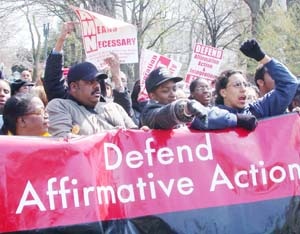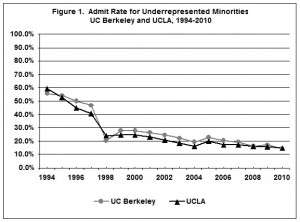Eight amicus (“friend of the Court”) briefs have been filed in support of the BAMN legal challenge to Prop 2. Briefs were filed by the following parties: 1) The Michigan Civil Rights Commission, (2) Committee of Law Professors and Constitutional Historians, (3) California Social Science Researchers and Admissions Experts; (4) the cities of Oakland and San Francisco and the counties of San Francisco and Alameda, (5) the California NAACP, (6) the City of Grand Rapids and (7) Distinguished Political Science Professors on the issue of how state-wide ballot measures are uniquely disadvantageous to minority interests, (8) Historians, Constitutional Scholars and Social Scientists (34 scholars who have devoted much of their careers to the study of the abolition movement, Reconstruction-era history, civil rights, and race relations.)
Click on the name above to access the link to the full brief. Excerpts from the Law Professors and Historians brief and the California Researchers and Admissions Experts brief can be found below [emphasis and subtitles added].
Committee of Law Professors and Constitutional Historians
 “The purpose of this brief is to place the dispute over affirmative action in Michigan’s public universities within a broader historical context. State constitutional amendments such as Proposal 2 are not uncommon in American history. In reaction to calls for reform from a minority group – whether it be the end of slavery, the enactment of non-discrimination laws, or the adoption of voluntary programs of racial integration – the majority has often responded by attempting to prevent the debate from occurring, by denying members of the minority group the opportunity to participate in the political process, or by making it impossible for the government to adopt the reform. State constitutional amendments like Proposal 2 are unconstitutional because they deny minority groups the equal right to achieve their goals through the normal political process.”
“The purpose of this brief is to place the dispute over affirmative action in Michigan’s public universities within a broader historical context. State constitutional amendments such as Proposal 2 are not uncommon in American history. In reaction to calls for reform from a minority group – whether it be the end of slavery, the enactment of non-discrimination laws, or the adoption of voluntary programs of racial integration – the majority has often responded by attempting to prevent the debate from occurring, by denying members of the minority group the opportunity to participate in the political process, or by making it impossible for the government to adopt the reform. State constitutional amendments like Proposal 2 are unconstitutional because they deny minority groups the equal right to achieve their goals through the normal political process.”
“… there is another common tactic – an illegitimate one – that is often utilized by members of the majority who resist reform. That is to distort the political process to make it more difficult for the minority than it is for the majority to obtain the passage of laws or adoption of policies that reflect its views or interests.”
Constitutional Amendments Used to Distort Democracy
“When the southern states made it impossible to limit or abolish the institution of slavery through the democratic process, it eventually transformed that conflict from a social, political, and economic contest into a military confrontation.”
“Foremost among the legal changes withdrawing slavery from the political process were amendments to the constitutions of many of the states that later formed the Confederacy that withdrew the power from the state legislatures to abolish slavery.”
Super-Majoritarian Barriers to Minority Participation
“For a century after the Civil War a similar pattern of illegitimate tactics was used to distort the political process and delay the attainment of civil rights for black citizens, including restrictions on speech, the right to vote, and super-majoritarian barriers to minority participation. As before the Civil War, these tactics both limited discussion of the issues and erected barriers to the democratic process.”
Different Time — Same Tactics
“Just as during the antebellum period the southern states made changes to their constitutions limiting the power of their state legislatures to abolish slavery, and during the Jim Crow era states adopted laws and constitutional amendments limiting the franchise, during the civil rights era a number of states enacted laws and constitutional amendments withdrawing power from their public institutions to adopt policies fostering racial integration. ”
“Michigan Proposal 2 makes it more difficult for public universities to integrate their institutions and makes it more difficult for African-Americans and other racial minorities to “seek aid from the government” in their admission to state universities.”
“The fact that Proposal 2 is a product of direct democracy does not diminish the fact that it is profoundly anti-democratic.”
“It is but one example of the long history of discriminatory state constitutional amendments and other laws adopted by the majority to prevent the minority from being able to make progress in civil rights through normal governmental channels.”
California Social Science Researchers and Admissions Experts
“When viewed in the context of rampant racial inequities in K-12 education, traditional measures of academic “merit,” such as standardized test scores and grade point average (GPAs), may be more accurately understood as measures of racial and economic privilege in America than as objective measures of ‘merit.'”
“An influential study by the UC Office of the President found that the SAT I predicts only 13 percent of the variance in UC freshmen GPA. This means that 87 percent of the variance in UC first-year college grades is not explained by how students performed on the SAT I…”
“Moreover, African American students are particularly vulnerable to being underestimated and mislabeled by standardized tests like the SAT. Research shows that African Americans often earn lower SAT scores due to “stereotype-threat,” the anxiety or stress triggered by the fear that one might fulfill or be associated with a relevant stereotype.”
~~~~~~~~~~~~~~~
“Students who successfully complete AP courses are awarded an additional grade point, which means that a ‘B’ grade in an AP course, for example, would be recorded as an ‘A’ grade, and so on. This treatment of AP courses explains why many students who take them are able to earn GPAs in excess of 4.0. In fact, the average GPA of students admitted to UC Berkeley and UCLA has far exceeded 4.0 in recent years.”
“… a great disparity in access to AP courses in California public high schools exists, and it runs along racial lines. “
“A recent study found that of the state’s top 50 high schools ranked by AP course offerings, whites made up 49 percent of the student population at these schools, Asian Americans made up 29 percent, Latina/os made up just 16 percent, and African Americans only 5 percent—despite the fact that these two latter groups have accounted for nearly half of all California high school graduates in recent years. In other words, whites and Asian Americans are significantly overrepresented at these AP-rich public high schools in California, while African Americans and Latina/os are woefully underrepresented.”
“…the “AP bump” rewarded in UC admissions schemes functions like affirmative action for white and Asian American applicants,
as these applicants are much more likely than their URM counterparts to attend high schools featuring a rich menu of the courses.”
~~~~~~~~~~~~~~~
 “… between 1996 and 1997, the African American share of enrollment at UC Berkeley’s law school plummeted from 7.6 percent to just 0.4 percent, while the Latina/o share was halved, from 10.6 percent to 5.2 percent. The declines for UCLA’s law school, while not as severe, were significant: the African American share declined from 6.2 percent in 1996 to just 2.6 percent in 1997, and the Latina/o share declined from 14.7 percent to 10.2 percent.”
“… between 1996 and 1997, the African American share of enrollment at UC Berkeley’s law school plummeted from 7.6 percent to just 0.4 percent, while the Latina/o share was halved, from 10.6 percent to 5.2 percent. The declines for UCLA’s law school, while not as severe, were significant: the African American share declined from 6.2 percent in 1996 to just 2.6 percent in 1997, and the Latina/o share declined from 14.7 percent to 10.2 percent.”
~~~~~~~~~~~~~~~
“… any increases [in URM enrollment] were immediately challenged by Proposition 209 advocates as evidence that either the campuses were lowering their standards (despite the fact that the mean GPAs and standardized test scores of admitted students continued to increase) or illegally practicing race-conscious admissions.”
“The elimination of race-conscious admissions has been particularly harmful for African American applicants to the top campuses. In 2006, for example, a front-page Los Angeles Times article reported the “startling statistic” that less than 100 African Americans were expected to enroll in a 2006 UCLA freshman class of about 5000 students—a low not seen since at least 1973. When black scholarship athletes were subtracted from that number,
less than 25 members of the state’s largest freshman class were projected to be black males.”
“That year, only 11.9 percent of black applicants to UCLA were presented with admissions offers—a rate that was less than half the campus’s overall admit rate of 25.8 percent.”
“Subsequently, UCLA implemented “holistic review” for the fall 2007 freshmen class… multiple readers were each now required to review every aspect of an applicant’s file—academic records, personal essays, records of personal achievement, and high school contextual information—in order to rate the applicant’s merit with a single “holistic” score.”
“But because UCLA’s new admissions scheme contributed to a 100 percent increase in the number of black freshmen enrolling in 2007 (over the 33-year low of less than 100 black freshmen in 2006), critics immediately cried foul.”
“Meanwhile, UCLA political science professor Tim Groseclose speculated that URMs might be gaining an unfair advantage by signaling their ethnicity in the personal essay portion of the application.”
“These incendiary public accusations stigmatized incoming black freshmen—who had posted a stellar mean GPA of 3.97
—and prompted UCLA to commission an independent audit of its reformed admissions process with only two years of data.”
“In 2010, the admit rate for African American applicants to UCLA was the lowest among all ethnic groups, 13.8 percent. Only 376 of the 2,729 black applicants to UCLA were admitted that year, and just 177 enrolled. The corresponding figures for UC Berkeley were even lower. The campus’s black admit rate of 12.9 percent translated into just 291 African Americans admits and 110 enrollees in 2010.”
“The system’s most prestigious campus had welcomed more than twice as many black freshmen in 1997, the last year of affirmative action.”
Join BAMN’s campaign to restore affirmative action!
